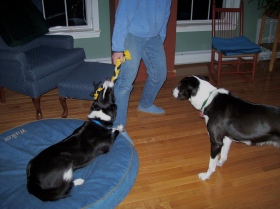My last Science Dog blog. “When Sit Doesn’t Mean S*it” reviewed a series of studies showing that training shelter dogs to sit on command is not as predictive of future adoption as was once assumed. Those results should not be interpreted as an argument against the benefits of training programs, but rather as evidence that there may be other factors involving shelter dogs, potential adopters and the shelter environment that may be more important to consider when looking at adoption rates and how to increase them.
Following the “sit” studies, Alexandra Protopopova and her research team set out to discover what, if anything, about dog-human visits might consistently predict adoption outcomes for dogs. They asked the question: “If sit doesn’t matter, what does?”.
What Matters: The researchers first studied 250 out-of-kennel visits between adoptable dogs and potential adopters at a municipal shelter in Florida (1). After selecting a dog to meet, shelter visitors interacted with dogs in either a small outdoor area, a larger, grassy outdoor area or a small indoor room. Multiple factors were examined during the interactions, including the dog’s appearance/breed/age, the dog’s behavior, and the visiting environment. Results: Overall, three factors stood out as significant predictors of an individual dog’s likelihood of adoption following these visits. These were:
- Willingness to play: A negative relationship was found between not playing and adoption. Those dogs who ignored play initiation by visitors were less likely to be adopted than those who did not ignore the adopter’s invitation to play. The converse of this is that dogs who wanted to play with the potential adopters were more likely to be adopted after the interaction.
- Lying close: Dogs who voluntarily laid down close to the human visitor were much more likely to be adopted than those who did not. (14 times as likely, in fact!)
- Visiting space: Visits that took place in the small, outdoor area were more likely to lead to successful adoptions than were those that occurred in the large, enclosed grass area or in the indoor room.

 LYING AT FEET AND ENGAGING IN PLAY ARE SIGNIFICANT PREDICTORS OF ADOPTION
LYING AT FEET AND ENGAGING IN PLAY ARE SIGNIFICANT PREDICTORS OF ADOPTION
What to do with this information? Here is where things get really cool. The researchers used the results from this study to design a simple program that could be used by shelters to improve adoption rates (2). And then, they tested the program to see if it actually worked. Science at its best.
Here is what they did:
Structured Interactions: The study included two experiments. In the first experiment, the researchers developed a play/toy preference assessment test and then used it to test the play preferences of 20 dogs. The dogs were retested several times over a period of three weeks to validate the accuracy of the tool. The second experiment used a modified version of the play preferences assessment to identify the toy preferences of a larger group of dogs at the shelter. Following their play preference testing, the dogs were assigned to two groups: (1) A structured interaction group in which potential adopters interacted with the dog with his/her preferred toy and then engaged in petting while an experimenter encouraged (lured) the dog to lie quietly at the visitors feet or (2) A control group in which the dog’s play preferences were not revealed and whose interactions with the potential adopter were unstructured. (Details of the play preference test and the structure interactions format are included in the paper). Data were collected on a total of 160 dog-adopter interactions.
Results: In the first experiment, play preference as measured by toy selection (tennis ball, nylon squeaky toy, cotton plush toy or flannel rope toy) was validated. This means that dogs who showed a preferred toy during the initial, short assessment continued to show the same preference when retested multiple times. However, it is significant to note that about one-third of the dogs (35 %) were not interested in playing with toys at all. (This is a point that the experimenters return to and address later). The import of this test lies more in the observation that simply asking dogs what type of toy that they preferred was helpful during future interactions, as found in the results of the second experiment. When the Structured Interaction group was compared with the Control group, striking differences emerged:
- Dogs in the structured interactions group (offered their preferred toy, encouraged to lie down at the visitor’s feet) spent less time ignoring the visitor’s invitations to play and more time in close proximity to the visitor.
- Dogs in the structured interactions group were also significantly more likely (2.5 times more likely, in fact!) to be adopted than were the control dogs.
- The duration of the interactions did not differ between the two groups, suggesting that using structured interactions did not take additional staff or volunteer time than traditional visits. In addition, results of a post-interaction questionnaire revealed that the visitors did not find the format of the structured interaction to be intrusive or to interfere with their ability to visit with the dog.
Take Away for Dog Folks
There are numerous ways in which this new information may be used to help shelter dogs. The initial set of studies showed that contrary to popular belief, teaching a dog to sit does not increase his or her chance for adoption (though it very well may have other benefits). Additionally, while multiple studies have shown that a dog’s appearance is one of the strongest factors that people use when initially selecting a dog (even though people tend to deny this when asked), appearance was not found to be important during subsequent out-of-kennel visits. Rather, during the actual visit with the dog, potential adopters react more to the dog’s play behavior and tendency to stay in close proximity (lying at feet) when making their adoption decision.
Let’s first look at play behavior: The use of the play preference test in this study is in-line with our increasing understanding of the welfare and emotional health benefits seen when we allow dogs to demonstrate their preferences and even better, to have a choice. This has become a bit of a buzz-word among trainers, but hyperbole and anecdotes aside, there is really nothing not to love about a shelter dog being allowed to choose his or her favorite toy and then carrying that toy into meet-and-greet areas for play with a new visitor.
Of course, nothing will be 100 percent effective or helpful. One of the caveats of the toy preference work was the finding that not all of the dogs in the shelter were interested in playing with toys. (I am sure this is not news to shelter staff). Of the dogs tested in the 2016 study, only about 2/3 could be easily enticed to play with a toy, regardless of the toy type. This finding is consistent with previous shelter dog studies that reported that only a minority of dogs played with toys and that object-play is often of very short duration. This may occur because of the stress of the shelter environment, an individual dog’s previous history (i.e. never having had toys or opportunities to learn to play) or a combination of factors.
For those of us who live with toy (and play) maniacs, this might be surprising to learn.
Still, it is very helpful information. Knowing that dogs who willingly play with visitors are more often adopted and that a substantial number of shelter dogs may be reluctant to play with toys can lead shelters to develop their own innovative programs to encourage play behaviors in dogs. This may include different types of toys such as food puzzles or encouraging more “people-oriented” types of play (more about this in the next blog piece).
Second, lying in proximity: In the structured interactions group, the researchers placed the dog on lead and then used a food lure to encourage the dog to stay close and/or to lie down near the visitor. While one could argue that this behavior was not voluntary and might not reflect a truly calm dog, helping a dog to focus on relaxing and to enjoy petting would allow the visitor to experience the dog while he or she is calm and quiet in a setting that is often not conducive to calm behavior in shelter dogs. In addition, this type of relaxation training is common in many dog training programs (including my own) and can be used as a way to classically condition dogs to remain calm and enjoy handling and petting. For shelters with training programs, this information suggests that training dogs to “lie at feet in a natural environment” might be an especially important exercise to emphasize.
Last, what I personally love best about this research is that it shows science working in the very best way that it can work – first to discover new knowledge, second to create a new approach or program from that knowledge, and third to test (and in this case confirm) the validity of the new program. In my view, a win-win for everyone involved – dogs, adopters and shelter professionals.
Cited References:
- Protopopova A, Wynne CDL. Adopter-dog interactions at the shelter: Behavioral and contextual predictors of adoption. Applied Animal Behaviour Science , 2014; 157:109 – 116.
- Protopopova A, Brandifino M, Wynne CDL. Preference assessments and structured potential adopter-dog interactions increase adoptions. Applied Animal Behaviour Science , 2016;176:87-95.


Reblogged this on Charlotte Phebe Post.
LikeLiked by 1 person
Thanks for the reblog, Charlotte!
LikeLiked by 1 person
Interesting relationship with Svartberg’s (2006) monumental work on breed temperament as related to working dogs and show. Some breeds much more playful. Show dogs less playful than working dogs.
LikeLike
I went to a m and g with a Weim in her foster’s home. There were several negatives (car sick, afraid of being left alone, afraid of strangers, large for her breed, preferred men – I am a female). Foster left to bring her to the living room, I sat on the floor & leaned on the sofa . Dog came in room & laid down by my leg, leaned on me. SOLD! 😍
LikeLiked by 1 person
Love this story, Barbara! Thanks for sharing!
LikeLike
Pingback: If Sit Doesn’t Matter, What Does? | Moder...